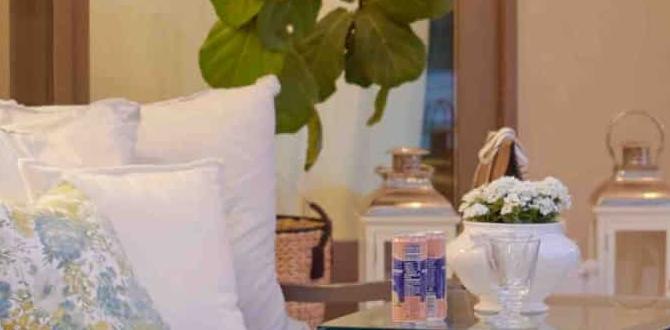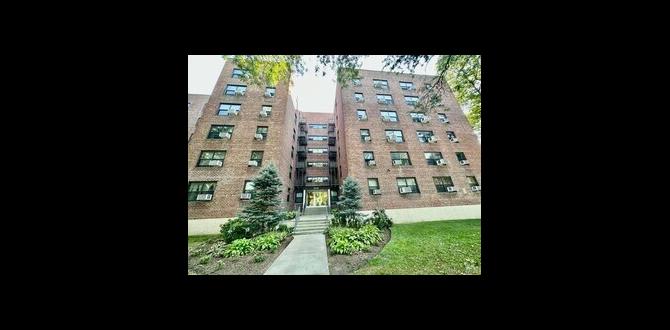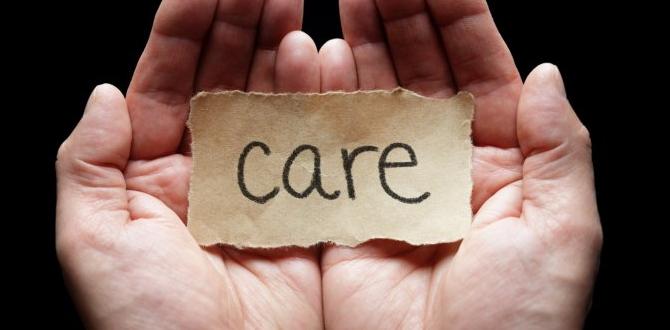Quick Summary:
Caring for indoor bamboo plants is simple! Provide bright, indirect light, water when the top inch of soil is dry, use well-draining soil, and fertilize lightly during the growing season. Watch for pests, maintain moderate humidity, and repot as needed for vibrant, happy bamboo.
So, you’ve brought home a beautiful indoor bamboo plant, and now you’re wondering how to keep it thriving. Don’t worry, it’s not as complicated as it might seem! Many people find it tricky to keep their indoor plants looking their best, and bamboo can seem a bit mysterious with its unique stalks. But with a few simple steps, you can ensure your lucky bamboo or other indoor varieties flourish and add a touch of green serenity to your home. Let’s break down the essential tips to help your indoor bamboo plant grow strong and happy. You’ll be a bamboo pro in no time!
Understanding Your Indoor Bamboo Plant
Indoor bamboo plants are a popular choice for many homes and offices, thanks to their elegant appearance and the calm atmosphere they can create. When we talk about “indoor bamboo,” we’re often referring to plants like Lucky Bamboo (Dracaena sanderiana), which isn’t true bamboo at all but shares a similar aesthetic. There are also true bamboo varieties that can be grown indoors in containers, though they require more specific care. This guide will focus on the general principles applicable to most indoor bamboo plants, with a special nod to the easy-care Lucky Bamboo.
These plants are loved for their air-purifying qualities and their association with good fortune in many cultures. However, like all plants, they have specific needs. Understanding these basic requirements is the first step to successful indoor bamboo care. We’ll cover everything from light and water to soil and common issues, making it easy for you to create the perfect environment.
Lucky Bamboo vs. True Bamboo Indoors
It’s important to know what kind of “bamboo” you have to tailor your care. Lucky Bamboo (often sold in water or soil) is actually a type of Dracaena. It’s very forgiving and low-maintenance, making it ideal for beginners. True bamboo (like Bambusa multiplex or Phyllostachys species) is a grass that grows much larger and typically needs more space, specific soil mixes, and careful pruning when grown indoors.
- Lucky Bamboo (Dracaena sanderiana): Very adaptable, can grow in water or soil, prefers indirect light, needs consistent moisture.
- True Bamboo (various species): Larger growth potential, requires well-draining soil, needs brighter light, can be prone to drying out or root rot if not watered correctly.
For the purpose of this guide, we’ll focus on general principles that apply to most indoor bamboo, with a slight emphasis on the beginner-friendly Lucky Bamboo.
Essential Care Tips for Indoor Bamboo Plants
Keeping your indoor bamboo happy is all about meeting its basic needs. Think of it like providing a cozy home with just the right amount of food, drink, and sunlight. We’ll walk through each element step-by-step.
1. Light Requirements: Bright, But Not Too Bright
Indoor bamboo plants generally prefer bright, indirect light. This means they love being in a room with plenty of natural light, but they don’t want to be scorched by direct sunbeams, especially during the hottest parts of the day. Too much direct sun can cause the leaves to turn yellow or brown and crispy.
- Ideal Placement: Near an east- or north-facing window is often perfect. If you only have south- or west-facing windows, place the plant a few feet away from the window, or use sheer curtains to diffuse the light.
- Signs of Too Little Light: Slow growth, leggy stalks, pale leaves.
- Signs of Too Much Light: Yellowing or brown, crispy leaf edges.
For Lucky Bamboo grown in water, the light needs are similar. Avoid direct sunlight, which can heat the water too much and encourage algae growth.
2. Watering Your Bamboo: The Sweet Spot
Watering is perhaps the most crucial aspect of indoor bamboo care, and it differs slightly depending on whether your bamboo is in soil or water.
a) Bamboo in Soil
When your bamboo is planted in soil, the key is to keep the soil consistently moist but not waterlogged. Think of it like a wrung-out sponge – damp, but not dripping wet. Overwatering is a common mistake that can lead to root rot, a serious problem for most plants.
- How to Check: Stick your finger about an inch into the soil. If it feels dry, it’s time to water. If it feels moist, wait a little longer.
- How to Water: Water thoroughly until you see water draining from the bottom of the pot. Discard any excess water that collects in the saucer after about 30 minutes to prevent the roots from sitting in water.
- Water Quality Matters: Especially for Lucky Bamboo, try to use filtered, distilled, or rainwater. Tap water can contain chlorine and fluoride, which can build up in the soil or water and harm the plant over time, leading to brown tips on the leaves. If you must use tap water, let it sit out for 24 hours to allow some of the chemicals to dissipate.
b) Bamboo in Water
Lucky Bamboo is very often sold growing directly in decorative stones and water. This method is simple, but it requires attentive water changes.
- Water Level: Ensure the bamboo stalks are always submerged in about 1-2 inches of water.
- Water Changes: Completely change the water every 1-2 weeks. This removes impurities, prevents bacterial growth, and refreshes the oxygen supply for the roots. Use the same types of water recommended for soil-grown bamboo (filtered, distilled, or rainwater).
- Cleaning: While changing the water, gently rinse the stones and the container to remove any slime or algae buildup.
3. Soil and Potting: Giving it a Good Home
Proper soil and drainage are vital for bamboo plants grown in pots.
- Soil Mix: Use a well-draining potting mix. A good standard is an all-purpose potting soil mixed with perlite or sand to improve drainage. For Lucky Bamboo planted in soil, a standard potting mix is usually sufficient, but ensure it’s not too heavy.
- Drainage Holes: This is non-negotiable! The pot MUST have drainage holes at the bottom. This allows excess water to escape, preventing root rot. If you have a decorative pot without holes (a cachepot), keep your plant in a nursery pot with drainage holes inside the cachepot, and empty any accumulated water.
- Choosing a Pot: Select a pot that is slightly larger than the root ball of your bamboo. For Lucky Bamboo, shallow, wide containers often work well. For true bamboo, a deeper pot may be needed as they grow.
4. Temperature and Humidity: Keeping it Comfortable
Indoor bamboo plants generally prefer average room temperatures and moderate humidity. They are quite adaptable to typical indoor conditions.
Temperature: Aim for temperatures between 65-80°F (18-27°C). Avoid placing your bamboo near heating or cooling vents, or in drafty areas, as sudden temperature fluctuations can stress the plant.
Humidity: While not overly demanding, bamboo appreciates a bit of humidity. If your home is very dry, especially in winter, you can increase humidity by:
- Placing the pot on a pebble tray filled with water (ensure the bottom of the pot isn’t submerged).
- Misting the leaves occasionally (though this is less effective for tall stalks).
- Grouping plants together, as they release moisture into the air.
- Using a small room humidifier.
5. Fertilizing: A Little Goes a Long Way
Bamboo doesn’t require heavy feeding. Over-fertilizing can be more harmful than under-fertilizing.
- When to Fertilize: Feed your bamboo plant during its active growing season, which is typically spring and summer. Avoid fertilizing in fall and winter when growth slows down.
- What to Use: Use a balanced liquid houseplant fertilizer diluted to half or quarter strength. For Lucky Bamboo grown in water, you can use specially formulated liquid plant food for lucky bamboo, or a very dilute all-purpose liquid fertilizer. A tiny amount is all that’s needed.
- Frequency: Fertilize about once a month during the growing season. Follow the instructions on your chosen fertilizer for dilution and frequency, but err on the side of less.
6. Pruning and Trimming: Maintaining Shape and Health
Pruning is generally minimal for indoor bamboo but can be useful for maintaining shape or removing damaged parts.
- Removing Yellow or Brown Leaves: Use clean, sharp scissors or pruning shears to cut away any discolored leaves. Cut back to the nearest healthy section or the base of the stalk.
- Shaping: If a stalk grows too tall or develops an undesirable shape, you can prune it back. Lucky Bamboo stalks often develop new shoots from where they are cut.
- Root Pruning (for potted true bamboo): If your true bamboo becomes root-bound, you might need to trim some roots during repotting.
7. Dealing with Pests and Diseases
Indoor bamboo plants are relatively pest-resistant, but they can still fall victim to common houseplant pests.
- Common Pests: Look out for spider mites (fine webbing), mealybugs (white, cottony masses), and scale insects (small, brown bumps).
- Inspection is Key: Regularly inspect your plant, especially the undersides of leaves and where leaves meet the stalks, for any signs of pests.Learn more about identifying and treating spider mites from The Old Farmer’s Almanac.
- Treatment:
- Mild Infestations: Wipe down the plant with a damp cloth or use a cotton swab dipped in rubbing alcohol to remove pests.
- More Severe Infestations: You can use insecticidal soap or neem oil for treatment. Always follow product instructions carefully and test on a small area of the plant first.
- Diseases: The most common issue is root rot, usually caused by overwatering. Ensure proper drainage and allow the soil to dry slightly between waterings.
8. Repotting: When Your Bamboo Needs More Space
Bamboo plants don’t need frequent repotting, but eventually, they may outgrow their pots.
- Signs It’s Time to Repot: Roots growing out of the drainage holes, water draining very quickly through the soil (indicating compacted soil or a root-bound plant), or the plant drying out much faster than usual.
- When to Repot: The best time to repot is in spring or early summer, at the beginning of the growing season.
- How to Repot:
- Choose a new pot that is only 1-2 inches larger in diameter than the current one. Ensure it has drainage holes.
- Gently remove the bamboo from its current pot. If it’s stuck, you can tap the sides of the pot or run a knife around the edge.
- If the roots are tightly bound together, you can gently loosen them with your fingers or a clean tool. For very dense root balls, you might trim off up to 1/3 of the outer roots with clean shears.
- Place a layer of fresh potting mix in the new pot.
- Position the bamboo in the new pot so the top of the root ball is about an inch below the rim.
- Fill in around the root ball with fresh potting mix, pressing gently to remove air pockets.
- Water thoroughly.
Troubleshooting Common Indoor Bamboo Issues
Even with the best care, you might encounter a few common problems. Don’t get discouraged – these are usually fixable!
Yellow Leaves
Yellow leaves on indoor bamboo can be caused by several factors:
- Overwatering: Roots become waterlogged, can’t breathe, and start to die, leading to yellowing of leaves. Ensure good drainage.
- Underwatering: The plant isn’t getting enough moisture. Check soil moisture regularly.
- Too Much Direct Sun: Leaves can scorch and turn yellow or brown. Move to a spot with indirect light.
- Low Humidity: Especially for true bamboo varieties in dry environments.
- Nutrient Deficiency: Less common, but possible if the plant hasn’t been fertilized in a long time.
Brown Leaf Tips or Edges
This is very common and often points to environmental factors:
- Dry Air: This is the most frequent culprit. Increase humidity.
- Mineral Buildup: If you’re using tap water, minerals like chlorine and fluoride can accumulate. Switch to filtered or distilled water, or allow tap water to sit out for 24 hours.
- Underwatering: The tips are the farthest from the roots and are the first to dry out.
- Fertilizer Burn: Using too much fertilizer can damage leaf tips. Always dilute properly.
Stunted Growth or Legginess
If your bamboo isn’t growing much or is becoming thin and stretched out:
- Insufficient Light: The plant is stretching to find more light. Move it to a brighter location with indirect light.
- Lack of Nutrients: If it hasn’t been fed in a while, a light feeding during the growing season might help.
Mold or Algae in Water (for water-grown bamboo)
This usually means the water needs changing more frequently, or the container needs cleaning.
- Solution: Change water more often (every week), scrub the container and stones with a mild soap and water solution, and rinse thoroughly before refilling. Keep the container out of direct sunlight, which encourages algae growth.
Choosing and Using the Right Pot for Bamboo
The container your bamboo lives in plays a vital role in its health and appearance. Here’s a look at what to consider:
| Pot Feature | Why It Matters for Bamboo | Best Options |
|---|---|---|
| Drainage Holes | Crucial to prevent root rot by allowing excess water to escape. | Pots with multiple holes at the bottom. |
| Material (Terracotta/Ceramic) | Terracotta is porous and helps soil dry out more evenly, good for plants prone to overwatering. Ceramic can be good if it has excellent drainage. | Unglazed terracotta, or glazed ceramic with adequate drainage. |
| Material (Plastic) | Lightweight and retains moisture longer, which can be good if you tend to underwater, but requires careful monitoring to avoid waterlogging. | Good quality plastic pots with plenty of drainage. |
| Size | Should be proportional to the plant’s root system. Too large can hold too much moisture; too small restricts growth. | Slightly larger than the current root ball; aim for 1-2 inches wider for repotting. |
| Cachepots (Decorative Pots) | Used to hide nursery pots, but ensure water doesn’t sit at the bottom. | Use with a nursery pot inside and empty excess water regularly. |
For Lucky Bamboo grown in water, the “pot” often becomes a decorative vase or container. The key here is that it should be deep enough to hold the stalks and allow their bases to be submerged, and ideally transparent so you can monitor water levels and clarity. However, if algae is an issue, an opaque container can be beneficial.
Frequently Asked Questions About Indoor Bamboo Care
Can I grow bamboo in just water?
Yes, Lucky Bamboo (Dracaena sanderiana) is very commonly grown in just water with decorative stones. Ensure the water is changed regularly and is clean. True bamboo varieties generally need soil to thrive.
How often should I water my indoor bamboo?
For soil-grown bamboo, water when the top inch of soil feels dry. For water-grown bamboo, change the water completely every 1-2 weeks.
What kind of water is best for indoor bamboo?
Filtered, distilled, or rainwater is best. Tap water can contain chemicals like chlorine and fluoride that can harm the plant over time, leading to brown leaf tips.
Why are my bamboo leaves turning yellow?
Yellow leaves can be caused by overwatering, underwatering, too much direct sunlight, or sometimes nutrient deficiency or mineral buildup from water. Assess




